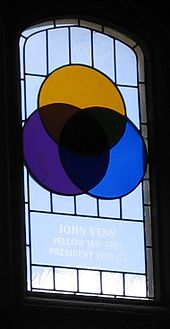John Venn | |
|---|---|
 | |
| Born | 4 August 1834 Kingston upon Hull, Yorkshire, England |
| Died | 4 April 1923 (aged 88) Cambridge, England |
| Alma mater | Gonville and Caius College, Cambridge |
| Known for | |
| Awards | Fellow of the Royal Society (1883) |
| Scientific career | |
| Fields | |
| Institutions | Gonville and Caius College, Cambridge |
| Signature | |



John Venn, FRS,[2][3] FSA[4] (4 August 1834 – 4 April 1923) was an English mathematician, logician and philosopher noted for introducing Venn diagrams, which are used in logic, set theory, probability, statistics, and computer science. In 1866, Venn published The Logic of Chance, a groundbreaking book which espoused the frequency theory of probability, arguing that probability should be determined by how often something is forecast to occur as opposed to "educated" assumptions. Venn then further developed George Boole's theories in the 1881 work Symbolic Logic, where he highlighted what would become known as Venn diagrams.
- ^ Cite error: The named reference
Venn1880was invoked but never defined (see the help page). - ^ Cite error: The named reference
a1926was invoked but never defined (see the help page). - ^ Cite error: The named reference
Pickleswas invoked but never defined (see the help page). - ^ Cite error: The named reference
Gibbinswas invoked but never defined (see the help page).